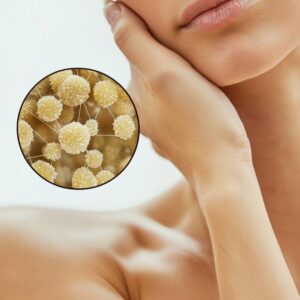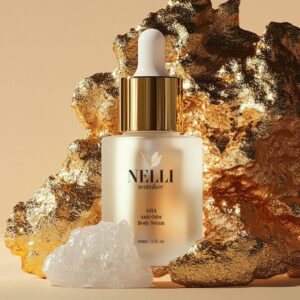
Let’s talk about it—bromhidrosis, that not-so-subtle body odour that deodorant commercials dance around but never really name. If your sweat seems to clear the room faster than a fire drill, you’re not alone—and you’re definitely not without options.
Below, we answer the most common (and least talked about) questions about bromhidrosis. So let’s get into the science, the smells, and the solutions.
Table of Contents
What is Bromhidrosis?
Bromhidrosis is a medical condition where your sweat develops a strong, unpleasant odor due to the breakdown of sweat by bacteria on the skin. This typically occurs in areas rich in apocrine glands, like the armpits, feet, and groin.

Here’s how it works:
- Sweat itself is usually odorless.
- But when it mixes with bacteria on the skin, particularly certain species like Corynebacterium, the bacteria break down sweat’s fatty acids and proteins.
- This breakdown produces volatile organic compounds (VOCs) that smell pungent—think sour, cheesy, or onion-like.
There are two main types:
- Apocrine bromhidrosis – happens after puberty and affects armpits/groin
- Eccrine bromhidrosis – related to general sweat, often affecting the feet
It’s not dangerous, but it can cause emotional and social stress. Fortunately, it’s highly treatable with lifestyle changes, skincare products, and sometimes medical intervention.
Would you like a graphic or diagram showing how bromhidrosis develops?
What Causes Bromhidrosis?
- Bacterial overgrowth
- Sweat gland activity (especially apocrine glands)
- Diet (spicy food, red meat, garlic, onions)
- Hormonal changes
- Tight clothing trapping moisture
- Certain medical conditions like diabetes or liver disorders
How is Bromhidrosis Different from Hyperhidrosis?
Bromhidrosis and hyperhidrosis are two very different sweat-related conditions, though they can sometimes overlap. Here’s the key difference:
🧼 Bromhidrosis = Bad Smell
- It’s all about odour.
- Caused when bacteria break down sweat, releasing smelly compounds.
- Most common in armpits, feet, groin.
- Sweat amount may be normal, but the smell is intense.
- Can be managed with antibacterial treatments, acidic serums, or deodorizing skincare.
💦 Hyperhidrosis = Excessive Sweating
- It’s all about quantity.
- Your body produces too much sweat, often for no clear reason.
- Can affect hands, feet, underarms, face, or the whole body.
- Sweat may not smell bad, but it’s overly abundant.
- Treated with clinical-strength antiperspirants, medications, or surgery.
Can You Have Both?
Yes—some people have both conditions. More sweat (hyperhidrosis) can create the perfect moist environment for bacteria, leading to bromhidrosis.
What Does Bromhidrosis Smell Like?
Bromhidrosis can produce a range of unpleasant odors, and the smell can vary depending on factors like diet, hygiene, and the specific bacteria involved. However, there are some common characteristics of what people with bromhidrosis might experience. The exact scent varies depending on your body chemistry, hygiene, diet, and the bacteria involved.
What Does it Smell Like?
- Sour or Vinegary Odor
- The breakdown of sweat by Corynebacterium bacteria often produces a sour or vinegary scent, which is one of the most common odors associated with bromhidrosis. It’s a sharp, pungent smell that’s hard to ignore.
- Cheese-like or Musty Odor
- Brevibacterium bacteria, often found on the feet, can produce a cheese-like, musty scent. It’s reminiscent of stinky feet and can sometimes linger even after showering.
- Onion-like Odor
- The bacteria that break down sweat proteins can produce a smell that’s similar to onions or garlic, often caused by the release of sulfuric compounds. This is common in the armpits and groin area.
- Body Odor or “Sweaty” Smell
- In less severe cases, the smell may just be a strong body odor that isn’t particularly distinct but is still noticeable. It can be described as overpowering sweat mixed with natural body oils.
- Rotten or Rotten Egg Odor
- In some cases, sulfur-producing bacteria may be involved, creating a smell that can resemble rotten eggs or decay, though this is less common.
Factors That Can Influence the Smell:
- Diet: Foods like garlic, spicy foods, or alcohol can make the odor stronger.
- Hygiene: Poor hygiene can increase bacteria buildup, making the smell more noticeable.
- Hormones: Hormonal changes (like during puberty or menstruation) can make the odor more intense.
- Clothing: Synthetic fabrics can trap sweat and bacteria, making the smell linger longer.
How Do You Know If You Have Bromhidrosis?
You may have it if:
- People frequently comment or react to your body odour
- Your clothes carry a lingering smell even after washing
- The smell appears shortly after showering
- Deodorants seem to stop working
- You notice yellow or dark stains in sweat-prone areas

What Bacteria Cause Bromhidrosis?
Bromhidrosis is primarily caused by bacteria that break down the sweat on your skin, creating strong, unpleasant odors. The bacteria responsible are usually naturally present on your skin, but certain types thrive in warm, moist environments where sweat is abundant—like the armpits, feet, and groin.
Key Bacteria Involved in Bromhidrosis:
- Corynebacterium
- These are the main culprits behind bromhidrosis. They thrive in moist environments and break down sweat into fatty acids and proteins, releasing smelly compounds (like thioalcohols, which have a strong odor).
- Commonly found in the armpits and groin.
- Staphylococcus
- Another type of bacteria that can contribute to body odor. It’s commonly found on the skin, and while it doesn’t produce as strong an odor as Corynebacterium, it can still contribute to the overall smell.
- Micrococcus
- Found on the feet and other body areas, this bacterium helps break down sweat, contributing to the unpleasant smell.
- Brevibacterium
- This bacterium is responsible for that cheese-like odor often associated with bromhidrosis. It thrives in areas where sweat accumulates, like the feet and groin.
How Does It Work?
- Sweat itself is odorless until it interacts with bacteria.
- When the bacteria break down components in the sweat, they produce volatile organic compounds (VOCs) that emit strong odors.
Managing Bacteria & Odor
Using antibacterial products or acidic body serums (like Nelli Neutralizer) can help reduce bacterial growth, minimize odor, and keep your skin fresh.
Is Bromhidrosis a Sign of Poor Hygiene?
No, it isn’t necessarily a sign of poor hygiene, but it can become more pronounced if proper hygiene isn’t maintained. It’s a complex condition that involves a combination of factors, including genetics, diet, hormones, and bacteria on the skin.

What Contributes to Bromhidrosis?
- Bacteria Interaction
It occurs when sweat mixes with bacteria on your skin. Even with excellent hygiene, some people’s bodies naturally produce sweat that attracts more bacteria, which causes odor. - Hormonal Changes
Teenagers, pregnant women, and people going through hormonal fluctuations can experience increased sweating, making bromhidrosis more likely. - Genetics
Your genes can determine how your sweat glands work. Some people are just more prone to producing sweat that has a stronger odor. - Diet
Foods like spicy dishes, garlic, and alcohol can increase body odor, even with perfect hygiene.
Does Good Hygiene Help?
While bromhidrosis isn’t caused by poor hygiene, regular showers and using antibacterial products can help reduce the odor. Daily washing and applying deodorants or body-neutralizing serums can help control the condition.
Is Bromhidrosis Contagious?
No, you can’t catch it from someone, and you can’t give it to someone else—even if you’re in close contact.
Here’s Why:
- It is caused by your own sweat and skin bacteria interacting on your body.
- Everyone has bacteria on their skin—it’s normal—but how your body produces and processes sweat is unique to you.
- The odor results from the breakdown of sweat by bacteria (like Corynebacterium), not from an infectious agent.
🚫 You Can’t “Catch” Bromhidrosis By:
- Sharing clothes or towels
- Hugging someone
- Using the same shower or gym equipment
However, sharing personal hygiene items isn’t recommended in general, as it can spread other skin bacteria or infections (like staph or fungal infections)—just not bromhidrosis itself.
What Are the Best Treatments for Bromhidrosis?
💧 Daily Hygiene Upgrades:
- Use antibacterial washes
- Dry thoroughly, especially underarms and feet
- Wear breathable, natural fabrics
🧴 Topical Solutions:
- Aluminum-based antiperspirants
- Acidic serums like glycolic acid or mandelic acid
- Nelli Neutralizer Anti Odor Serum – formulated to neutralize odour at the source without irritating your skin.
💊 Bromhidrosis Treatment with Antibiotics:
Doctors may prescribe topical antibiotics like:
- Clindamycin
- Erythromycin
- Mupirocin
These kill the offending bacteria directly on the skin.
Can Bromhidrosis Be Cured?
Bromhidrosis can often be significantly reduced or even eliminated, but whether it’s fully “cured” depends on the cause and how your body responds to treatment.
✅ Good News: Most Cases Are Treatable
Many people manage symptoms successfully by:
- Practicing strict hygiene
- Using antibacterial washes or acid-based serums
- Wearing breathable clothing
- Avoiding odour-triggering foods
💊 Medical Treatments Can Help
- Topical antibiotics (like clindamycin or erythromycin)
- Prescription-strength antiperspirants
- Chemical exfoliants (like glycolic acid)
- Odour-neutralizing serums (like Nelli Neutralizer)
🛠️ In Severe Cases: Surgery Is an Option
If nothing else works, gland-removal procedures or sweat gland curettage can drastically reduce or eliminate the condition.
So, Is It Curable?
- Yes—for many people, bromhidrosis can be resolved with the right routine.
- For others, it becomes a manageable skin condition rather than a permanent one.
What About Surgery for Bromhidrosis?
Surgery for bromhidrosis is typically considered a last resort—but in severe or resistant cases, it can be highly effective.
🩺 When Is Surgery Considered?
If you’ve tried everything—topical treatments, hygiene changes, prescription products—and the odour is still affecting your quality of life, surgery may be recommended.
✂️ Types of Bromhidrosis Surgery:
- Apocrine Gland Removal (Surgical Excision)
- Involves physically removing the odor-producing glands from the underarm area.
- Very effective, but may leave scars or cause skin tightness.
- Subdermal Curettage
- A scraping technique that removes sweat glands through a small incision.
- Less invasive than full excision and often used with liposuction.
- Laser Sweat Gland Ablation
- Uses laser heat to destroy apocrine glands.
- Minimally invasive with quicker recovery time.
- Microwave Therapy (e.g. miraDry®)
- Uses thermal energy to eliminate sweat glands non-surgically.
- FDA-approved and can reduce both sweat and odor.
⚠️ Risks to Consider:
- Scarring
- Nerve damage
- Incomplete odour removal
- Sweat compensating in other areas (compensatory sweating)
👃 Is It Worth It?
For people who experience serious emotional or social distress, surgery can be life-changing. But always explore non-invasive treatments first and consult with a dermatologic surgeon.
What Foods Make Bromhidrosis Worse?
Some foods contain compounds that get released in sweat and intensify odour:
- Red meat
- Garlic and onions
- Alcohol
- Caffeinated drinks
- Processed junk foods
Can Teenagers Get Bromhidrosis?
Yes, it’s actually very common during puberty.
Here’s why:
🔬 Hormones Wake Up the Sweat Glands
During puberty, apocrine sweat glands (located in the armpits, groin, and feet) become active. These glands produce a thicker type of sweat, rich in proteins and fats—aka the perfect food for odor-causing bacteria.
🦠 Bacteria + Sweat = Odour
When that sweat gets broken down by skin bacteria, it produces the strong, often embarrassing body odour we associate with bromhidrosis.
👕 Other Contributing Factors in Teens:
- Poor hygiene routines (or rushed showers)
- Tight synthetic clothing
- Stress, which can trigger sweat
- Hormonal fluctuations
Final Thoughts: You’re Not Alone
If you’re dealing with bromhidrosis, it’s not your fault—and it’s more common than people admit. The key is understanding what’s happening on a biological level and using science-backed solutions that really work.
You deserve to feel fresh and confident in your skin. 💛




